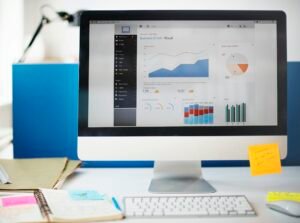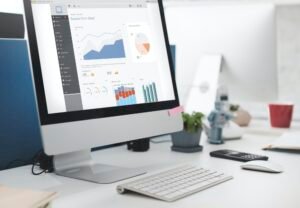Introduction
Digital dashboards have become essential for businesses in today’s data-driven world. These dashboards visually represent key business metrics and data, allowing organizations to monitor performance, make informed decisions, and drive business success. This article will explore the importance of digital dashboards in business and discuss the benefits, best practices, and key metrics to track when using these tools. We will also provide insights on choosing the right digital dashboard for your business and address common challenges and pitfalls to avoid.
The Benefits of Using Digital Dashboards for Business Insights
Real-time data tracking: One of the primary benefits of using digital dashboards is the ability to track real-time data. Traditional reporting methods often involve manual data collection and analysis, which can be time-consuming and prone to errors. With digital dashboards, businesses can access up-to-date information instantly, allowing them to monitor performance metrics in real time. This real-time tracking enables organizations to identify trends, spot potential issues, and adjust their strategies promptly.
Improved decision-making: Digital dashboards provide businesses with valuable insights that can inform decision-making processes. By visualizing key metrics and data clearly and concisely, decision-makers can quickly identify patterns, trends, and correlations that may not be apparent in raw data. This enhanced visibility enables organizations to make more informed decisions based on accurate and relevant information.
Increased efficiency and productivity: Digital dashboards streamline the process of accessing and analyzing data, saving time and effort for employees. Instead of manually compiling reports from various sources, employees can access the dashboard to view all the necessary information in one place. This increased efficiency allows employees to focus on more strategic tasks and improves overall productivity within the organization.
Better collaboration and communication: Digital dashboards promote team collaboration and communication by providing a centralized platform for sharing information. With a shared dashboard, team members can easily access and interpret data, fostering a culture of transparency and accountability. This collaborative approach encourages cross-functional teams to work together towards common goals and facilitates data-driven discussions and decision-making.
How to Choose the Right Digital Dashboard for Your Business
Identify your business needs: Before selecting a digital dashboard, it is important to identify your specific business needs and goals. Consider the key metrics and data most relevant to your organization and determine the customization and flexibility required. Understanding your business needs will help you choose a dashboard that aligns with your objectives and provides the necessary functionality.
Consider the features and functionalities: Different digital dashboards offer various features and functionalities, so it is important to evaluate these options before deciding. Consider whether you need real-time data tracking, customizable visualizations, data integration capabilities, or collaboration features. Assessing the features and functionalities will help you determine which dashboard best meets your business requirements.
Evaluate the cost and scalability: Cost is an important factor to consider when choosing a digital dashboard. Evaluate the pricing models of different vendors and determine whether they offer a scalable solution that can grow with your business. Consider licensing fees, implementation costs, and ongoing maintenance expenses. It is also important to assess the scalability of the dashboard to ensure it can handle increasing data volumes as your business grows.
Best Practices for Building Effective Digital Dashboards
Define your goals and objectives: Before building a digital dashboard, clearly define your goals and objectives. Determine what you want to achieve with the dashboard and what key metrics you need to track. This will help you design a dashboard focusing on the most relevant data and providing actionable insights.
Please keep it simple and user-friendly: Simplicity is key when designing a digital dashboard. Avoid cluttering the dashboard with unnecessary information or complex visualizations. Keep the layout clean and intuitive, making it easy for users to navigate and interpret the data. Use clear labels, headings, and tooltips to provide context and ensure the dashboard is user-friendly for all stakeholders.
Use relevant and actionable data: To make the most of your digital dashboard, focus on using relevant and actionable data. Avoid including data that does not contribute to your business goals or decision-making processes. Instead, select key metrics that provide meaningful insights and drive action. Use data visualizations that effectively communicate the message and highlight important trends or patterns.
Regularly update and maintain the dashboard: A digital dashboard is only effective if it is kept up-to-date. Regularly update the data and metrics displayed on the dashboard to ensure accuracy and relevance. Establish a dashboard maintenance process, including data validation, error checking, and regular reviews. This will help ensure that the dashboard remains a valuable tool for decision-making.
Key Metrics to Track on Your Digital Dashboard
Revenue and sales performance: Tracking revenue and sales performance is crucial for any business. A digital dashboard can provide real-time visibility into sales figures, revenue growth, and customer acquisition rates. By monitoring these metrics, businesses can identify trends, evaluate the effectiveness of marketing campaigns, and make informed decisions to drive revenue growth.
Customer satisfaction and engagement: Customer satisfaction and engagement are key indicators of business success. A digital dashboard can track customer feedback, Net Promoter Score (NPS), customer retention rates, and social media sentiment. By monitoring these metrics, businesses can identify areas for improvement, measure the impact of customer experience initiatives, and make data-driven decisions to enhance customer satisfaction.
Website traffic and conversion rates: For businesses with an online presence, tracking website traffic and conversion rates is essential. A digital dashboard can display metrics such as website visits, page views, bounce rates, and conversion rates. By monitoring these metrics, businesses can identify opportunities to optimize their website, improve user experience, and increase conversion rates.
Social media engagement and reach: Social media has become a powerful marketing tool, and tracking social media engagement and reach is crucial for businesses. A digital dashboard can display likes, shares, comments, and follower growth metrics. By monitoring these metrics, businesses can evaluate the effectiveness of their social media strategies, identify popular content, and make data-driven decisions to improve engagement and reach.
Data Visualization Techniques for Creating Engaging Dashboards
Use charts, graphs, and tables: Data visualization techniques such as charts, graphs, and tables can make your digital dashboard more engaging and interpretable. Use bar charts, line graphs, pie charts, or scatter plots to represent data visually. Choose the appropriate visualization type based on the data you present and the insights you want to convey.
Incorporate color and design elements: Color and design elements can enhance the visual appeal of your digital dashboard. Use a color scheme that is visually appealing and aligns with your brand identity. Incorporate design elements such as icons or images to make the dashboard more visually engaging. However, be mindful not to overuse colors or design elements that may distract from the data.
Highlight important data points: Use visual cues such as bold colors or larger font sizes to draw attention to important data points or trends. This will help users quickly identify key insights without analyzing the entire dashboard. Highlighting important data points can also help guide decision-making by focusing on critical areas.
Use interactive features: Interactive features such as drill-down capabilities or filters can enhance user experience and engagement with the digital dashboard. Allow users to interact with the data by providing options to filter or drill down into specific metrics or periods. This interactivity lets users explore the data more deeply and gain deeper insights.
Integrating Multiple Data Sources into Your Digital Dashboard
Identify relevant data sources: To create a comprehensive digital dashboard, it is important to integrate data from multiple sources. Identify the relevant data sources for your business, such as CRM systems, marketing automation platforms, financial systems, or social media platforms. Consider the data most critical to your business objectives and ensure it is included in the dashboard.
Use data integration tools: Data integration tools can simplify integrating multiple data sources into your digital dashboard. These tools allow you to connect to various data systems, extract the necessary data, and transform it into a format easily visualized on the dashboard. Choose a data integration tool that aligns with your business requirements and provides the necessary functionality.
Ensure data accuracy and consistency: When integrating multiple data sources, it is important to ensure data accuracy and consistency. Establish data validation processes to identify and resolve any discrepancies or errors in the data. Regularly review and validate the data sources to ensure the dashboard displays accurate and reliable information. Inaccurate or inconsistent data can lead to incorrect insights and decisions.
Using Digital Dashboards for Real-Time Monitoring and Decision Making
Set up alerts and notifications: Digital dashboards can be configured to send alerts or notifications when certain metrics or thresholds are met. Set up alerts for key performance indicators (KPIs) or critical metrics that require immediate attention. This real-time monitoring enables businesses to respond quickly to changes or issues and make timely decisions.
Monitor key performance indicators: Key performance indicators (KPIs) are essential metrics that measure the success of a business or specific objectives. A digital dashboard can display KPIs in real-time, allowing businesses to monitor performance against targets or benchmarks. By tracking KPIs, businesses can identify areas for improvement, measure progress towards goals, and make data-driven decisions.
Make data-driven decisions: Digital dashboards provide businesses with valuable insights that can inform decision-making processes. By analyzing the data displayed on the dashboard, businesses can identify trends, patterns, or correlations that may not be apparent in raw data. This data-driven approach enables organizations to make informed decisions based on accurate and relevant information.
Common Challenges and Pitfalls to Avoid When Using Digital Dashboards
Overcomplicating the dashboard: One common challenge when using digital dashboards is overcomplicating the design or including too much information. Avoid cluttering the dashboard with unnecessary data or complex visualizations. Keep the layout simple and intuitive, focusing on the most relevant metrics and insights. A cluttered or confusing dashboard can hinder user adoption and make it difficult to derive meaningful insights.
Focusing on irrelevant data: Another challenge is focusing on irrelevant data or metrics that do not contribute to business objectives. When designing a digital dashboard, it is important to identify the key metrics that align with your goals and decision-making processes. Avoid including data that does not provide actionable insights or contribute to business success.
Neglecting data accuracy and consistency: Data accuracy and consistency are crucial for effective digital dashboards. Neglecting data validation processes or failing to review and update data sources can lead to inaccurate or inconsistent information on the dashboard. Establish processes to ensure data accuracy and consistency, including regular reviews, validation checks, and error resolution.
Not updating the dashboard regularly: A common pitfall is neglecting to update the dashboard regularly. As business conditions change, updating the data and metrics displayed on the dashboard is important to ensure accuracy and relevance. Establish a dashboard maintenance process, including regular updates, data validation, and error checking. An outdated dashboard can lead to incorrect insights and decisions.
Conclusion: Leveraging Digital Dashboards to Drive Business Success
In conclusion, digital dashboards have become an essential tool for businesses seeking valuable insights from their data. These dashboards provide real-time tracking, improved decision-making, increased efficiency, and better organizational collaboration. By choosing the right digital dashboard for your business, following best practices for building effective dashboards, and tracking key metrics, you can leverage these tools to drive business success.
Digital dashboards visually represent key business metrics and data, allowing organizations to monitor performance, make informed decisions, and drive business success. You can ensure that the dashboard meets your needs by selecting the right digital dashboard for your business, considering features and functionalities, and evaluating cost and scalability.
Building effective digital dashboards requires defining goals and objectives, keeping the dashboard simple and user-friendly, using relevant and actionable data, and regularly updating and maintaining the dashboard. Following these best practices can create a dashboard that provides valuable insights and drives data-driven decision-making.
Key metrics to track on your digital dashboard include revenue and sales performance, customer satisfaction and engagement, website traffic and conversion rates, and social media engagement and reach. By monitoring these metrics, businesses can identify trends, measure performance, and make data-driven decisions to drive business success.
Data visualization techniques such as charts, graphs, tables, color, design elements, highlighting important data points, and using interactive features can make your digital dashboard more engaging and easier to interpret. By incorporating these techniques, you can effectively communicate insights and engage users with the dashboard.
Integrating multiple data sources into your digital dashboard requires identifying relevant data sources, using data integration tools, and ensuring data accuracy and consistency. By integrating data from various sources, businesses can comprehensively view their performance and make informed decisions based on accurate information.
Digital dashboards can be used for real-time monitoring and decision-making by setting up alerts and notifications, monitoring key performance indicators (KPIs), and making data-driven decisions. By leveraging real-time data and insights from the dashboard, businesses can respond quickly to changes or issues and make timely decisions.
Common challenges and pitfalls to avoid when using digital dashboards include overcomplicating the design or including irrelevant data, neglecting data accuracy and consistency, and not updating the dashboard regularly. By addressing these challenges and pitfalls, businesses can ensure that their digital dashboards remain effective and provide accurate insights.
In conclusion, digital dashboards are a powerful tool for businesses seeking valuable insights from their data. By leveraging these tools, businesses can monitor performance, make informed decisions, and drive business success. Start using digital dashboards for your business today and unlock the potential of your data.
If you’re interested in learning more about digital dashboards, Studio Insighters has a comprehensive guide on CMO dashboards. This article provides valuable insights and tips on creating effective dashboards for Chief Marketing Officers. Check it out here.







